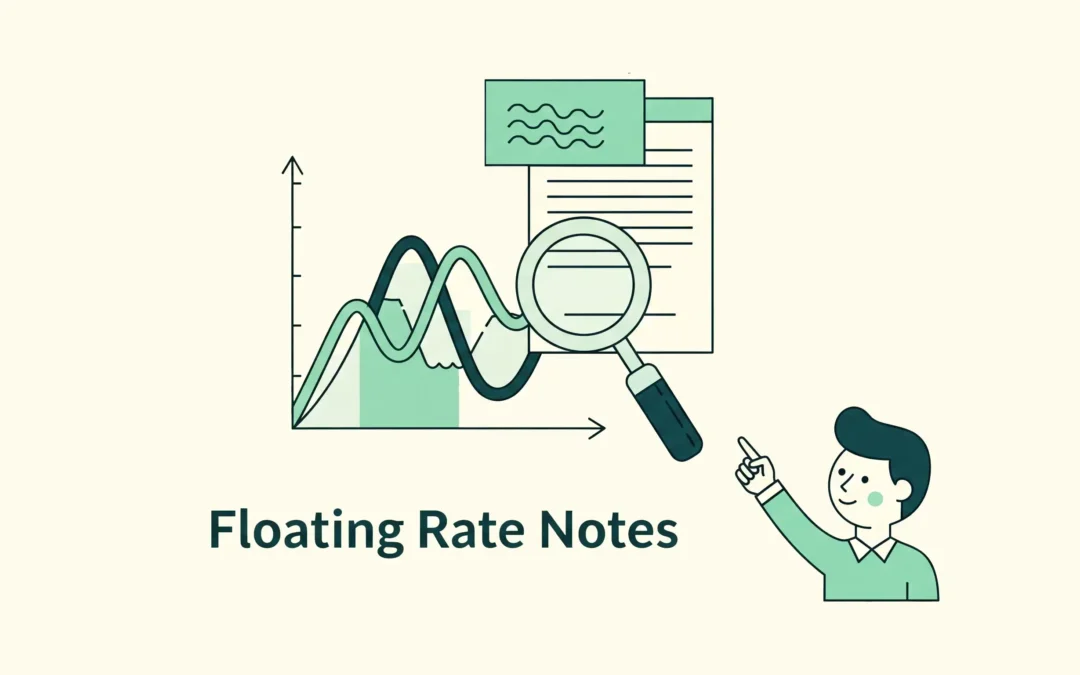Apart from equity, there are various other debt instruments that are good for investments. FRNs or floating rate notes are one of such investment options. Investors who prefer lower risk on their investment often prefer it. But the question is, how to invest in them? Which platform offers it, and who is it suitable for? Let us get all the answers to these questions.
This article will explain FRN in detail, along with helping you to know the steps through which you can invest in it.
What Are Floating Rate Notes?
Debt instruments known as floating rate notes (FRNs) pay a variable interest rate as opposed to a fixed one. The interest rate, also known as the coupon, is correlated with benchmark rates such as MCLR in India or SOFR internationally. While LIBOR was traditionally used, it is now being phased out globally.
Key Features
- Variable Interest Rate: Depending on market benchmarks, the coupon fluctuates over time.
- Reset Times: It is very frequently reset, usually every three or six months
- Less Price Volatility: Compared to fixed-rate bonds, less impacted by changes in interest rates
- Published by: the government, public sector organisations, banks, or corporations
- Maturity Period: Varies from one year to more than five years.
Ways to Invest in Floating Rate Notes in India?
Let us look at how to invest in floating-rate notes in India:
1. Floating Rate Savings Bonds issued by the RBI
Retail investors frequently choose these bonds, which are issued by the Reserve Bank of India.
- Interest rate: Resets every six months and is linked to the National Savings Certificate (NSC) rate plus a spread of approximately 0.35%.
- Duration: 7 years
- Minimum Investment: Rs. 1,000.
- Taxation: Interest income is subject to full taxation.
- Where to Purchase: Prominent banks and internet marketplaces such as SBI, HDFC, and ICICI
2. FRN-Expected Debt Mutual Funds
- Numerous debt-oriented mutual funds have specific FRN schemes or invest in floating rate instruments.
- Benefits include high liquidity, diversification, and expert fund management.
- Ideal For: Investors seeking FRN passive exposure
- For instance, search for funds listed on Groww, Zerodha Coin, or Paytm Money under the “Floating Rate Funds” category.
3. Bonds with corporate floating rates
- FRNs are issued either privately or publicly by a few highly regarded Indian corporations.
- Returns are higher than government FRNs, but there is a credit risk.
- Bond dealers, wealth management platforms, and private placement are some modes of investment.
- Suitability: Perfect for knowledgeable investors who are able to evaluate the risk and credibility of issuers
4. Platforms for Online Bond Markets
Additionally, investors can purchase FRNs on the secondary market by:
- Retail Direct by RBI
- NSE GoBID
- Platforms and brokers with authorisation
Why Consider Investing in FRNs?
You may be thinking whether you should invest in FRNs or not:
1. Protect Yourself from Increasing Interest Rates
The coupon on FRNs rises with interest rates, so your returns increase over time. In contrast to fixed-income instruments, which might depreciate in an environment of rising rates, FRNs are therefore more flexible.
2. Reduced Interest Rate Risk (Duration Risk)
When interest rates increase, the value of fixed-rate bonds frequently declines. However, because FRNs’ coupon rates reset frequently, they are less susceptible to these fluctuations and contribute to price stability.
3. Diversification of Fixed-Income Investments
Spreading risk in your portfolio can be achieved by including FRNs. Particularly when balancing short-term and long-term investments, their distinct structure enhances other fixed-income assets.
4. Appropriate for cautious investors
Government-issued FRNs, such as RBI bonds, offer modest returns with capital protection. They are ideal for retirees or risk-averse investors seeking steady income with low equity market volatility. However, corporate FRNs carry higher risk and require careful evaluation.
5. Consistent Income with Adaptability
FRNs give your income a dynamic edge by ensuring you are not locked into antiquated interest terms through periodic interest payments that match benchmark rates.
Bottomline
The conclusion can be drawn that FRNs are debt instruments with floating interest rates, typically issued by governments or corporations. In India, rates are linked to benchmarks like MCLR, while internationally, LIBOR is being replaced by SOFR or other rates. The market condition is a major factor in determining the net returns that the investor will receive. It is advised to opt for it if you are looking for medium to long-term investment options.
However, research by the investor must be done on a personal level to see if this investment option aligns with your goals or not.


